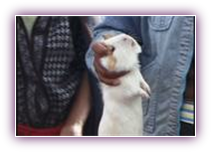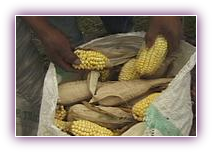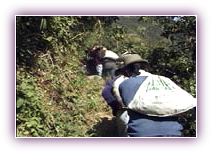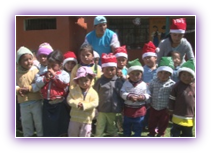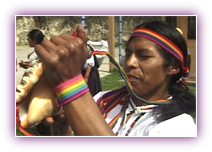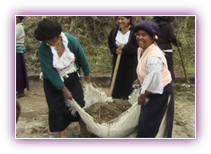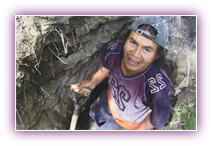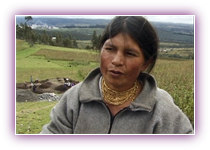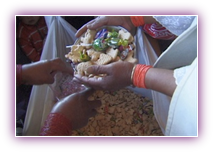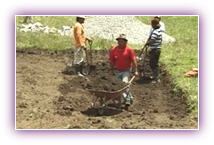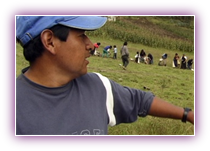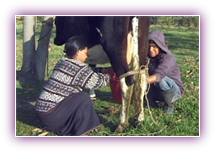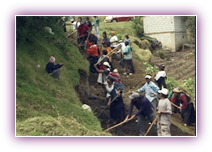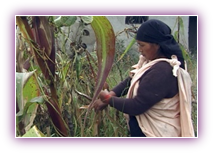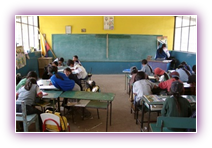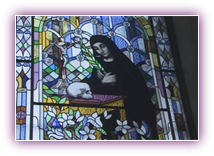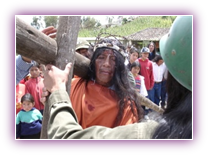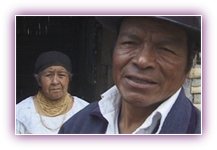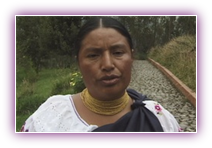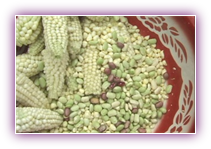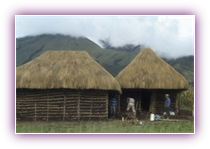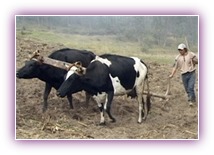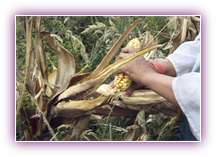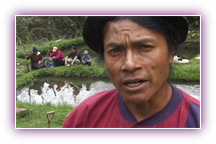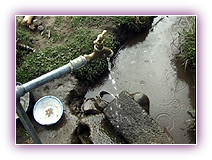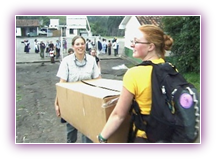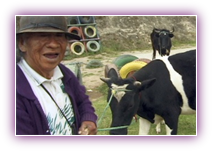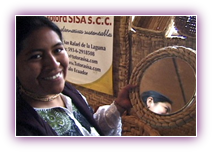All otavalovideos.com videos are owned and copyrighted 2019 by Frank M. Kiefer. Reproduction is prohibited. All rights reserved.
If you have any questions please write to videos@otavalovideos.com
If you have any questions please write to videos@otavalovideos.com
In the rural communities near Otavalo, the Minga is taken quite seriously! The Andean custom of working for the benefit of the community predates the Incans by hundreds of years. This Minga was called to repair canals that bring irrigation water to the village.
Sra. Maria Enma Perugachi, president of the small Andean community of Yambiro, speaks (in Quechua) of the many needs that the construction of the Yambiro Community/Health Center will address. These needs are common throughout the Andean rural areas!
Community unity through Minga brings water to the Otavalo campesinos. Five communities lived without water for almost four years. With funding for materials, the reparation of the main reserve tank was achieved through this ancient Andean tradition.
Campesinos throughout the Sierra of Ecuador are harvesting the most important crop of the Andean Indigenous people, Maize. José Maria Perugachi and his entire family spent the day today working in the fields. Notice that even the children participate!
The Indigenous campesinos near Otavalo are responsible for maintenance of roads passing through their villages. Through the ancient tradition of Minga, community members work for a few hours two Sundays of each month. Note the general mood.
Saturday morning visit to the Otavalo Animal Market is still one of my favorite things to do! Cuy is a Andean Indigenous delicacy offered to guests of honor at fiestas. Buying a cuy is not easy. It involves close examination and good negotiation technique.
The Essence of the Minga
Community Minga
Navidades
The Needs of the Andean Community
Reenacting Ancient Rituals
Rural children of Ecuador look forward to receiving "navidades", bags filled with animal crackers and candies. Christmas in rural Ecuador is celebrated with the Christmas Eve Mass and a simple meal.
Stephanie Dunning of Florida spent 7 months living in the Community of Yambiro. As part of the Global citizens Year Student Volunteer program, Stephanie taught in the village school, helping by teaching English.
Navidades

Global Community Year Volunteers
Andean Minga
Buying a Cuy
Harvesting Maize
Christmas for the rural Indigenous children of the Andes is a time to receive candy and animal crackers. I have finally found time to edit a video taken a few months ago when our foundation distributed navidades to over 200 children from the community of Yambiro.
Lic. José Manuela performs an ancient Andean Indigenous ceremony to mark the end of another successful year for the Yambiro child care program. Materials are presented throughout the year by the Ali Shungu Foundation and the U33 foundation.
Construction of the Yambiro Community Center
With the financial assistance of travelers, the village of Yambiro has spent three years building a Community Health Center. This is Part 1 of a video documenting the construction. Completion is near and OtavaloVideos will follow progress from start to finish!
Construction of the Yambiro Community Center continued
Master builder Jaime Ramirez explains this community project on the first day of preparation at the construction site. Building materials are moved to the site by hand by community members. Young and old participate.
Fresh milk is always in demand and milking the family cow is a chore that I enjoy watching. Each family has a couple of cows, a few pigs and perhaps a lamb or two. If the family needs cash, they sell an animal.
Milking the Family Cow
Beans and Maize are the staple of the rural Indigenous family. For the next month families will be harvesting the beans dried on the vine that will provide their food for the entire year. In June the final harvest of Maize begins.
Cosechando Frejole
It has been years since I have been to the Quechua Mass on Easter in Otavalo. The older people of Otavalo still take Easter very seriously! It is the music of the choir during the Mass that I truly enjoy. These are a few short excerpts of the Mass and the music.
Dr. Allison Hall and Sr. Patricio Castro spent two weeks in two small Indigenous villages near Otavalo working with the children of the local schools. They taught health, art, phys. ed. and provided the kids with a great experience. This is their video.
Volunteering in the Rural Schools
Quechua Mass in Otavalo
Semana Santa in Andean Rural Communities
Paradero Inca Tambo, "The House of Their Grandparents"
The Importance of an Education
Today I visited the Paradero Inca Tambo in Peguche to visit with Tio Mario Tontaquimba Diaz and his wife who welcome guests to visit their workshops and to obtain insight into the Indigenous Andean culture of the Otavalo rural area.
Spanish Quechua
Spanish Quechua
The new school year begins this Monday. Tia Eugenia Farinango, an Indigenous Community leader, explains the need for financial assistance to educate the young people of the rural areas. Please help support he Ali Shungu Foundation Scholarship program!
The first harvest of the year is taking place in the Otavalo area. Fresh corn, choclo, and beans, frejoles de chagra” are staples for the Indigenous campesino. Even José, the family pig, is involved and does his part of the chores.
How to Build a Choza
The Ancient Otavalos lived in thatched adobe huts called “chozas” for many centuries. An Otavalo Indian remembers watching villagers build these huts in his mountain village as a young boy and he offered his expertise when we needed some chozas fast!
Preparing the Fields
Now that the maize has been harvested it is once again time to prepare the fields for planting corn and beans in September. The indigenous farmers of Otavalo continue to plow and hoe the earth by hand or with oxen. Tractors are for rent, but very expensive.
A day long investigation of the water system serving thousands of rural indigenous people was documented last month. In part 1 the issues and principal problems are explained by representatives of the communities.
This is the time of year for the third harvest of corn planted last October. Maize is still a very important factor in the lives of the Otavalo campesino! The maize will be dried and ground into flour or stored and roasted slowly on ceramic plates to make tostado.
Ten villagers from the town of Larcacunga, using Otavalo land, are looking for funding to finance a community project to build pools for trout farming. The project will benefit the local diet and provide an activity to attract travelers. Any help is welcomed!
Harvest of Maize in Rural Communities
Building a Small Business Enterprise, Trout Farming
Water Projects for Rural Communites near Otavalo
From the U.S to Otavalo, Providing Health & Goodwill
Vets and students from the University of Wisconsin visited several Indigenous pueblos last month to treat cattle, pigs, dogs, sheep and humans for parasites. Dr. Chris Olsen and his team vaccinated over 200 animals in Yambiro, assuring better health for all!
Just a few kilometers from Otavalo, right on Lago San Pablo, one finds the very charming town of San Rafael. The villagers have produced “esterras”, straw mats, for centuries . They are now diversifying by producing a wide variety of products. Worth a visit!
Through the efforts of The Tandana Foundation a Chlorine producing machine has been purchased and donated to the water administration of 5 communities. The unit will provide treated water for over 3000 persons. This video documents the ceremony.
Totora Sisa, Community Business in San Rafael
5 Communities Receive Water Treatment Apparatus
OTAVALOVIDEOS.COM Rural Andean Community





























Global Community Year Volunteers
Community unity through Minga brings water to the Otavalo campesinos. Five communities lived without water for almost four years. With funding for materials, the reparation of the main reserve tank was achieved through this ancient Andean tradition.
Saturday morning visit to the Otavalo Animal Market is still one of my favorite things to do! Cuy is a Andean Indigenous delicacy offered to guests of honor at fiestas. Buying a cuy is not easy. It involves close examination and good negotiation technique.
Campesinos throughout the Sierra of Ecuador are harvesting the most important crop of the Andean Indigenous people, Maize. José Maria Perugachi and his entire family spent the day today working in the fields. Notice that even the children participate!
The Indigenous campesinos near Otavalo are responsible for maintenance of roads passing through their villages. Through the ancient tradition of Minga, community members work for a few hours two Sundays of each month. Note the general mood.
In the rural communities near Otavalo, the Minga is taken quite seriously! The Andean custom of working for the benefit of the community predates the Incans by hundreds of years. This Minga was called to repair canals that bring irrigation water to the village.
Sra. Maria Enma Perugachi, president of the small Andean community of Yambiro, speaks (in Quechua) of the many needs that the construction of the Yambiro Community/Health Center will address. These needs are common throughout the Andean rural areas!
Christmas for the rural Indigenous children of the Andes is a time to receive candy and animal crackers. I have finally found time to edit a video taken a few months ago when our foundation distributed navidades to over 200 children from the community of Yambiro.
Lic. José Manuela performs an ancient Andean Indigenous ceremony to mark the end of another successful year for the Yambiro child care program. Materials are presented throughout the year by the Ali Shungu Foundation and the U33 foundation.
With the financial assistance of travelers, the village of Yambiro has spent three years building a Community Health Center. This is Part 1 of a video documenting the construction. Completion is near and OtavaloVideos will follow progress from start to finish!
Master builder Jaime Ramirez explains this community project on the first day of preparation at the construction site. Building materials are moved to the site by hand by community members. Young and old participate.
The first few truck loads of materials were passed down to the building sight by hand during the first few mingas. Moving tonnage the 100 mtrs. got old quickly so someone suggested they all build a road that morning…...and that is exactly what they did!
The first few truck loads of materials were passed down to the building sight by hand during the first few mingas. Moving tonnage the 100 mtrs. got old quickly so someone suggested they all build a road that morning…...and that is exactly what they did!
Beans and Maize are the staple of the rural Indigenous family. For the next month families will be harvesting the beans dried on the vine that will provide their food for the entire year. In June the final harvest of Maize begins.
Fresh milk is always in demand and milking the family cow is a chore that I enjoy watching. Each family has a couple of cows, a few pigs and perhaps a lamb or two. If the family needs cash, they sell an animal.
Dr. Allison Hall and Sr. Patricio Castro spent two weeks in two small Indigenous villages near Otavalo working with the children of the local schools. They taught health, art, phys. ed. and provided the kids with a great experience. This is their video.
It has been years since I have been to the Quechua Mass on Easter in Otavalo. The older people of Otavalo still take Easter very seriously! It is the music of the choir during the Mass that I truly enjoy. These are a few short excerpts of the Mass and the music.
The celebrations this week are the holiest of holy celebrations. Many communities re-enact the Roman persecution and crucifixion of Christ. This is a slide show of photos I took a few years ago in the community of Yambiro. Music soundtrack is by Pacha Mama.
Today I visited the Paradero Inca Tambo in Peguche to visit with Tio Mario Tontaquimba Diaz and his wife who welcome guests to visit their workshops and to obtain insight into the Indigenous Andean culture of the Otavalo rural area.
Quechua Spanish
Quechua Spanish
The new school year begins this Monday. Tia Eugenia Farinango, an Indigenous Community leader, explains the need for financial assistance to educate the young people of the rural areas. Please help support the Ali Shungu Foundation Scholarship program!
The first harvest of the year is taking place in the Otavalo area. Fresh corn, choclo, and beans, frejoles de chagra” are staples for the Indigenous campesino. Even José, the family pig, is involved and does his part of the chores.
The Ancient Otavalos lived in thatched adobe huts called “chozas” for many centuries. An Otavalo Indian remembers watching villagers build these huts in his mountain village as a young boy and he offered his expertise when we needed some chozas fast!
Now that the maize has been harvested it is once again time to prepare the fields for planting corn and beans in September. The indigenous farmers of Otavalo continue to plow and hoe the earth by hand or with oxen. Tractors are for rent, but very expensive.
This is the time of year for the third harvest of corn planted last October. Maize is still a very important factor in the lives of the Otavalo campesino! The maize will be dried and ground into flour or stored and roasted slowly on ceramic plates to make tostado.
Ten villagers from the town of Larcacunga, using Otavalo land, are looking for funding to finance a community project to build pools for trout farming. The project will benefit the local diet and provide an activity to attract travelers. Any help is welcomed!
A day long investigation of the water system serving thousands of rural indigenous people was documented last month. In part 1 the issues and principal problems are explained by representatives of the communities.
Just a few kilometers from Otavalo, right on Lago San Pablo, one finds the very charming town of San Rafael. The villagers have produced “esterras”, straw mats, for centuries . They are now diversifying by producing a wide variety of products. Worth a visit!
Through the efforts of The Tandana Foundation a Chlorine producing machine has been purchased and donated to the water administration of 5 communities. The unit will provide treated water for over 3000 persons. This video documents the ceremony.
Vets and students from the University of Wisconsin visited several Indigenous pueblos last month to treat cattle, pigs, dogs, sheep and humans for parasites. Dr. Chris Olsen and his team vaccinated over 200 animals in Yambiro, assuring better health for all!
Rural children of Ecuador look forward to receiving "navidades", bags filled with animal crackers and candies. Christmas in rural Ecuador is celebrated with the Christmas Eve Mass and a simple meal.
Stephanie Dunning of Florida spent 7 months living in the Community of Yambiro. As part of the Global citizens Year Student Volunteer program, Stephanie taught in the village school, helping by teaching English.
The celebrations this week are the holiest of holy celebrations. Many communities re-enact the Roman persecution and crucifixion of Christ. This is a slide show of photos I took a few years ago in the community of Yambiro. Music soundtrack is by Pacha Mama.
Shelling Beans
Andean Minga
OTAVALOVIDEOS.COM Rural Andean Community
Buying a Cuy
Harvesting Maize
The Essence of
the Minga
the Minga
Community Minga
The Needs of the Andean Community
Navidades
Reenacting Ancient Rituals
Construction of the Yambiro Community Center
Construction of the Yambiro Community Center continued
Construction of the Yambiro Community Center continued
Construction of the Yambiro Community Center continued
Cosechando Frejole
Milking the Family Cow
Volunteering in the Rural Schools
Quechua Mass in Otavalo
Semana Santa in Andean Rural Communities
Paradero Inca Tambo, "The House of Their Grandparents"
The Importance of an Education
Shelling Beans
How to Build a Choza
Preparing the Fields
Harvest of Maize in Rural Communities
Building a Small Business Enterprise, Trout Farming
Water Projects for Rural Communites near Otavalo
Totora Sisa, Community Business in San Rafael
5 Communities Receive Water Treatment Apparatus
From the U.S to Otavalo, Providing Health & Goodwill
